
Embedded Software Development: A Comprehensive Guide
Suprabhat Sen | December 30, 2024 , 15 min read
Table Of Content
Pause and ask yourself how we got here. How did we go from landlines to phones that fit in our pockets and appliances that learn our habits? Another question you should be asking is what makes these devices so “smart”? The answer is embedded software.
Found in almost all electronic devices, embedded software development is still an enigma to many. This blog explores the art and science of building software that lives inside the devices we rely on daily, and its benefits for industries like IoT, automotive, and healthcare.
Key Takeaways
- Embedded software powers the technology we rely on every day including smart devices, medical equipment, and cars.
- IDEs, debuggers, and real-time operating systems make the development process efficient and reliable.
- Choosing the right development partner involves assessing technical expertise, industry experience, and a commitment to collaboration and support.
What Is Embedded Software Development?
- What Is Embedded Software Development?
- Types of Embedded Software Systems
- 4 Benefits of Embedded Software for Businesses
- Must-Have Features in Embedded Software
- 7 Steps in Embedded Software Development
- Key Tools You Can Use To Build Embedded Software
- Real-World Examples of Embedded Software
- Key Tips for Developing Effective Embedded Software
- How to Choose the Right Development Partner for Embedded Software?
- How Can ScaleupAlly Help?
- Conclusion
- Frequently Asked Questions
This is the process of designing programs that reside in hardware, giving them the ability to think, react, and perform specific tasks. Unlike the software you download on your laptop for general purposes, embedded software is built to control the internal workings of hardware.
Types of Embedded Software Systems
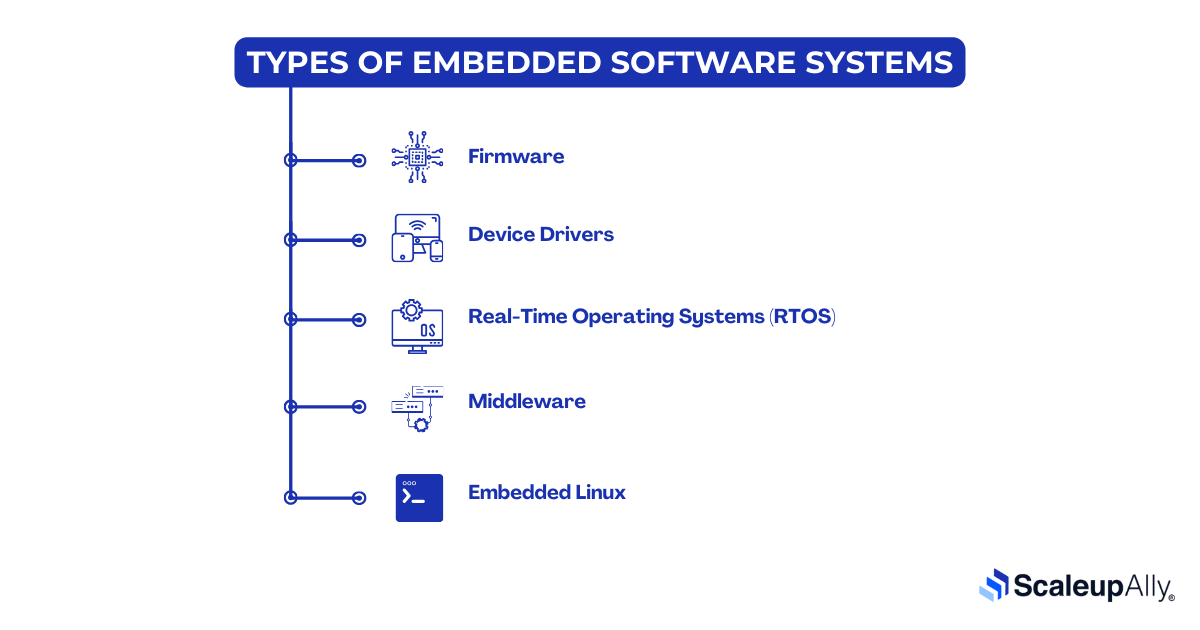
Embedded software systems come in different forms, each one of them meeting specific needs.
1. Firmware
It’s the permanent software that provides basic functionality to hardware. Firmware keeps devices running without needing updates or attention.
2. Device Drivers
Device drivers are like interpreters for your hardware and software. They help the two speak the same language by ensuring components like sensors, motors, and screens respond as they should. Your device would be unable to function as a whole without them.
3. Real-Time Operating Systems (RTOS)
RTOS ensures processes happen exactly when they’re needed for systems where every millisecond matters. Think of the brakes in your car or a robotic arm on an assembly line.
4. Middleware
Middleware is the problem solver that connects everything. It provides the tools and frameworks developers rely on to make complex systems work without starting from scratch. It’s the reason your smart devices can handle tasks like syncing with your apps or managing network connections seamlessly.
5. Embedded Linux
Embedded Linux is the operating system of choice for devices that need more than just basic functionality. From advanced industrial machines to your smart TV, Embedded Linux offers flexibility, scalability, and a touch of sophistication that simpler systems can’t provide.
4 Benefits of Embedded Software for Businesses
Embedded software empowers businesses to innovate and cut costs. Here are some benefits of embedded software systems:
1. Streamlining Operations
Have you noticed that on a factory floor, machines know exactly what to do without constant human supervision? That’s embedded software at work automating processes, reducing downtime, and boosting productivity.
2. Customized Solutions
No business is the same, so why should their technology be the same, right? Embedded software allows companies to create solutions designed just for them. Businesses can craft systems that solve their unique challenges without extra baggage.
Also Read: Custom Software Development: What is it And Best Practices
3. Reliability
Customers expect products that just work, no excuses. Embedded software is built for consistency to keep devices running smoothly even in tough conditions. For businesses, this means fewer complaints, fewer returns, and a reputation that speaks for itself.
4. Fueling Innovation
The future belongs to companies that dare to innovate. Embedded software makes it possible to dream up the next big thing. It’s the foundation for creating redefining products.
Must-Have Features in Embedded Software
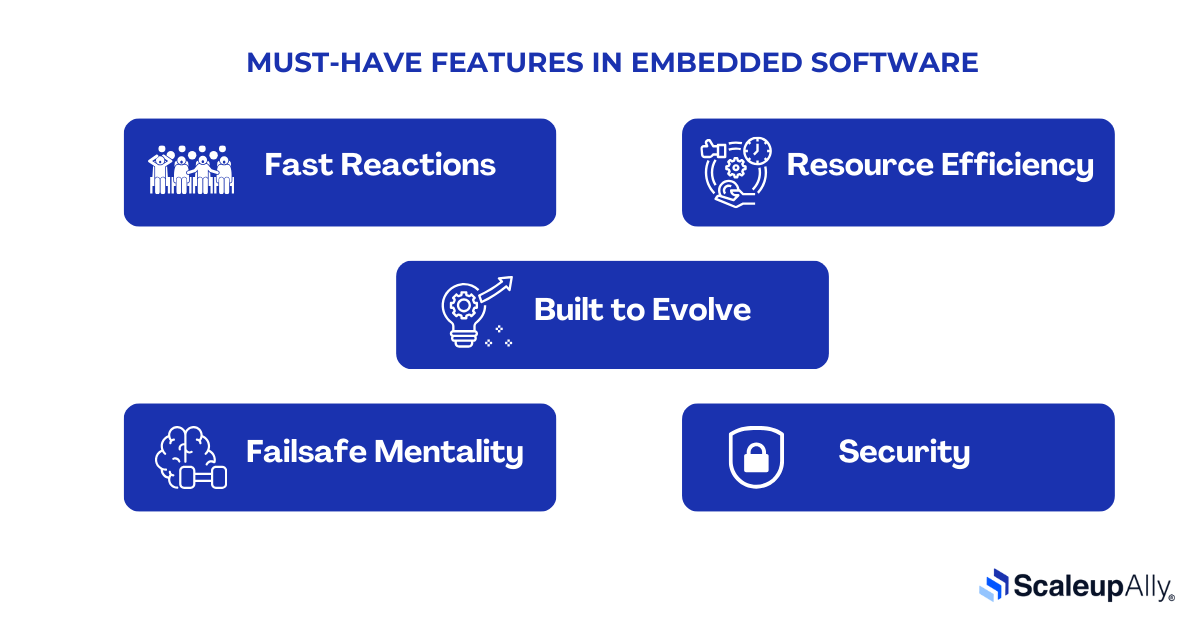
For embedded software to thrive, it needs to go beyond basic functionality. The best systems share key traits that ensure they’re not just operational, but exceptional. Here are some must-have features:
1. Fast Reactions
Delays can be dangerous when it comes to stabilizing a drone in mid-air or managing a medical device for example. The ability to react in real-time is non-negotiable.
2. Resource Efficiency
Embedded software often works on hardware with limited memory, low power, and constrained processing power. The challenge? Making every byte, watt, and clock cycle count.
3. Built to Evolve
Technology moves fast, and embedded systems can’t afford to lag behind. Scalability and adaptability let software keep pace even if it’s adding new features or adapting to unforeseen demands. A good system grows with you, not against you.
4. Failsafe Mentality
Glitches happen. But when they do, embedded software needs to catch them gracefully. Smart error-handling doesn’t just prevent problems from escalating, it keeps systems running when you need them most.
5. Security
With interconnected devices in this world, embedded software can’t afford to be a weak link. Encryption, authentication, and secure coding practices will ensure that it can stand up to threats no matter how persistent.
7 Steps in Embedded Software Development
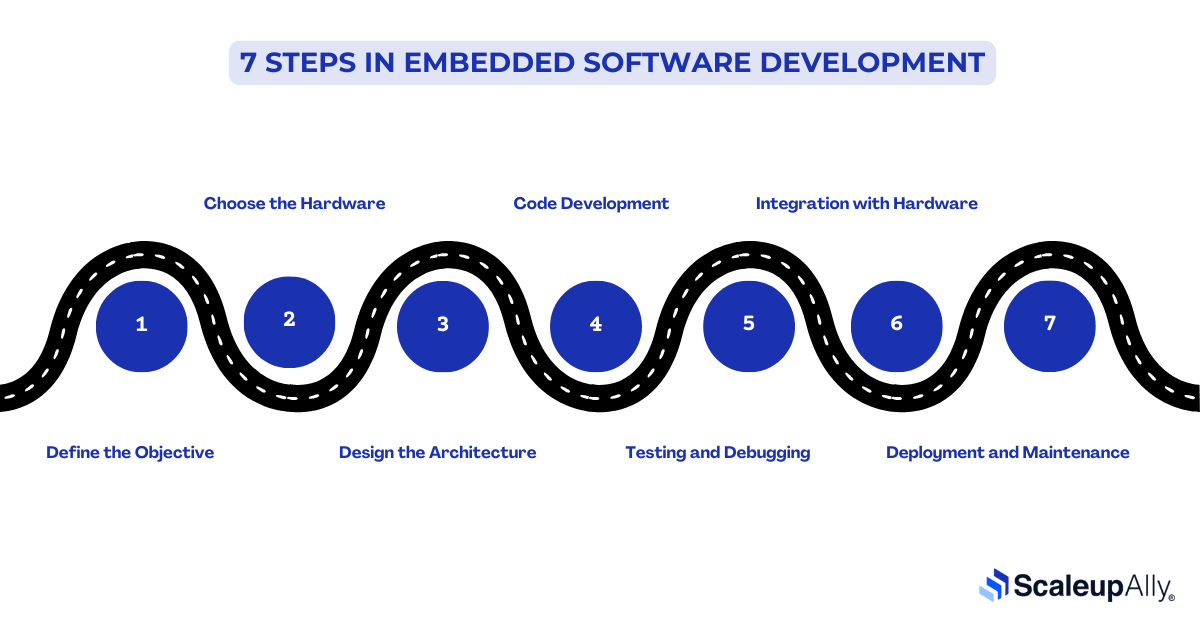
These steps form the backbone of reliable and efficient embedded systems:
1. Define the Objective
What is the software supposed to do? This might sound simple, but nailing down clear, specific goals ensures the development process stays focused. Is it controlling an industrial robot? Powering a wearable fitness tracker? Knowing the “why” shapes the entire approach.
2. Choose the Hardware
Microcontrollers, sensors, and actuators all need to be selected carefully, as they form the ecosystem where the software will live. Choose what fits the job.
3. Design the Architecture
Here’s where the blueprint takes shape. Developers map out how the system will function by breaking down tasks, deciding on priorities, and defining how components interact. A good architecture is flexible enough to handle future changes.
4. Code Development
This is where writing the software, line by line, happens and requires technical skill and some creativity. The focus is on clarity, efficiency, and maintaining control over every bit and byte.
5. Testing and Debugging
No software is perfect on the first try. Testing under real-world conditions is crucial to catch bugs and ensure reliability. You need to also Debug to understand how the system behaves.
6. Integration with Hardware
Once the code has been tested and debugged, the next step is to ensure that the software and the hardware are compatible and are able to “communicate”.
7. Deployment and Maintenance
Once the software has been integrated with the hardware, it can now be deployed. When deployed, embedded systems need to be monitored for changes.
Key Tools You Can Use To Build Embedded Software
Building embedded software requires the right tools to empower developers to create robust, efficient systems. Here are some of these tools you can rely on:
1. Integrated Development Environments (IDEs)
An IDE is where you write, edit, and debug your code. Tools like Keil or MPLAB X combine everything into one workspace to save you the time of juggling multiple programs.
2. Compilers and Assemblers
Code doesn’t speak hardware’s language on its own so you need compilers and assemblers to translate your work into machine-readable instructions. GCC, for instance, is a popular choice.
3. Debugging Tools
Bugs aren’t just frustrating; they can stall progress. Debuggers, whether hardware-based like JTAG or software-focused, let you pinpoint issues, step through your code, and keep your system on track.
4. Simulators and Emulators
Before diving into hardware testing, simulators and emulators give you a virtual sandbox to experiment in. Tools like Proteus let you prototype and troubleshoot without the risk of frying physical components.
5. Version Control Systems
When working on embedded projects, tracking changes is critical. Version control tools like Git give you a record of every edit so that you can backtrack.
6. Real-Time Operating Systems (RTOS)
When timing is a necessity, an RTOS like FreeRTOS ensures tasks run smoothly in other to prioritise critical operations so nothing misses a beat.
7. Hardware Monitoring Tools
Sometimes, the code works perfectly, but the hardware doesn’t play along. Logic analyzers and oscilloscopes help you see what’s happening in the physical world by showing signals and revealing missteps.
8. Static and Dynamic Analysis Tools
For clean, efficient code, these tools are invaluable. They help you catch issues before they escalate like memory leaks and performance bottlenecks so that your software runs as intended.
9. Hardware-Specific SDKs
Manufacturers often provide SDKs for their devices. These kits come with pre-written libraries and examples to take some of the guesswork out of development.
Real-World Examples of Embedded Software
Let us now take a look at some of the best examples of embedded software:
1. Smart Home Devices
Embedded software turns ordinary household items into intelligent systems. Just think about doorbells that send live video to your phone when you are not home. We could even take the Nest thermostat that monitors and adjusts your home’s temperature based on your preferences for example. Embedded algorithms make that possible.
2. Cars That Think
Have you ever felt your brakes kick in before you did? That’s embedded software at work. Modern cars are packed with embedded software that controls engine performance and safety features like anti-lock braking systems (ABS), airbag controllers, and adaptive cruise control.
3. Wearables Technologies
Your fitness tracker knows how far you ran today, and a pacemaker knows when to correct a heartbeat. These devices collect and process data in real-time to give you insights or even prevent medical emergencies.
4. Industrial Automation
Factories run better with embedded systems at their core. Robots assembling products, conveyor belts sorting items, and sensors monitoring equipment performance all rely on embedded software to operate with precision and efficiency.
5. Consumer Electronics
Think about your smartphone, your gaming console, or even your microwave. Embedded software is what makes these devices responsive, useful, and sometimes even fun. Without it, they’d just be lifeless boxes of circuits.
6. Aerospace Systems
Planes that fly on autopilot, satellites that send us weather updates, and rovers exploring Mars are all possible because of embedded software.
7. Internet of Things (IoT)
The Internet of Things has made everything smarter. Your fridge, your watch, and even your coffee machine communicate because of embedded systems.
Key Tips for Developing Effective Embedded Software
Here are some tips to help you create embedded software that stands out:
1. Start with Clear Requirements
Know exactly what the software needs to do before you write a single line of code. Is it managing a sensor? Controlling a motor? Defining clear objectives from the start will save you from rework and frustration later.
2. Keep it Simple
Embedded systems often run on limited resources, so simplicity is key. Avoid overengineering or adding unnecessary features. Clean, efficient code not only performs better but is easier to debug and maintain.
3. Prioritize Real-Time Performance
For systems that operate in real-time, like automotive brakes or medical devices, timing is everything. Make sure your software is designed to process data and execute commands within strict time constraints because every millisecond counts.
4. Optimize for Hardware
Your software and hardware need to work in perfect sync. Understand the hardware’s limitations (whether it’s memory, power, or processing speed) and write code the right code. Test directly on the hardware as often as possible.
5. Test, Test, Test
Mistakes in embedded software can lead to hardware failures or even safety risks. Thorough testing (unit tests, integration tests, and hardware-in-the-loop simulations) is non-negotiable. Test for edge cases, unexpected inputs, and real-world conditions.
6. Plan for Updates
Even the best software isn’t perfect. Build mechanisms to allow for updates, whether it’s bug fixes or new features. Over-the-air (OTA) updates are particularly useful in IoT devices and consumer electronics.
7. Focus on Power Efficiency
For battery-operated devices, energy efficiency can make or break the user experience. Optimize your code to minimize power consumption by using features like sleep modes and efficient scheduling.
8. Use Modular Design
Divide your software into smaller, reusable modules. Not only does this make the code easier to understand and maintain, but it also allows you to swap out components or add features without overhauling the entire system.
9. Document Everything
Good documentation is an essential part of the development process. So, comment on your code and create user manuals. Clear documentation ensures your software remains usable and maintainable.
10. Keep Security in Mind
Embedded systems, especially those connected to the internet, are vulnerable to cyber threats. Use secure coding practices, encrypt sensitive data, and implement authentication protocols to safeguard your software.
How to Choose the Right Development Partner for Embedded Software?
Here’s what you should keep in mind when choosing the right partner for embedded systems software development:
1. Understand Their Approach, Not Just Their Skills
Yes, technical expertise matters. But it’s their approach that will define your experience. Do they adapt to challenges? Can they think creatively to solve problems? A great partner is a collaborator.
2. Find Industry Relevance
Not all industries are created equal. If you’re building medical devices or automotive systems, you’ll need someone who speaks that language. Their past work should show they’ve navigated similar waters and know the specific hurdles you’ll face.
3. Talk, Don’t Assume
Communication can make or break a partnership. Your ideal team won’t just send you updates. Instead, they’ll have real conversations about progress, challenges, and solutions. Look for transparency and a willingness to collaborate.
4. Look at What They’ve Done
Their portfolio should tell a story. But don’t stop at what looks good. Ask about the nitty-gritty. What was their role? How did they tackle unique challenges? Did their solutions truly deliver results?
5. Customization
Your project is unique, and your partner should treat it that way. Avoid teams that try to sell you one-size-fits-all solutions. Instead, look for flexibility and a focus on tailoring the software to your exact needs.
6. Gauge Their Commitment to Testing
Embedded systems can’t afford bugs, especially when lives or critical processes are involved. A good partner will emphasize rigorous testing and debugging to ensure reliability in real-world scenarios and not just in ideal conditions.
7. Ask About Security
Connected devices are a playground for hackers. Your development partner must prioritize security from day one using best practices to protect your software from vulnerabilities and threats.
8. Check Their Vision for the Long Haul
Deployment isn’t the end but the beginning of maintenance, updates, and scaling. A reliable partner will offer support for the future and not just deliver and disappear.
9. Match Your Values
Cheap and fast isn’t always better. A true partner will work within your constraints without compromising quality or ethics. Find someone whose values align with yours and who prioritises delivering a product that works.
How Can ScaleupAlly Help?
Every growing business hits a point where its ambition collides with the reality on the ground which could be a stalled project, an idea too complex to tackle alone, or the feeling that you could do more if only you had the right team in your corner. That’s where ScaleupAlly comes in perfectly.
We take the time to understand your challenges, your goals, and your vision for what’s next (whether it’s building embedded software or helping you scale your tech to keep pace with your dreams) by approaching every challenge like it’s the most important thing we’ll do all year.
However, we’re more than a software development partner. We’re the team that asks the questions you didn’t think to ask. The ones who show up with fresh ideas when the usual answers won’t cut it. With ScaleupAlly, you get more than expertise; you get a collaboration built on trust, creativity, and a shared drive to make things happen.
So, how can ScaleupAlly help? By showing how far your business can go when you’re not doing it alone. Partner with us and you will never walk alone.
Conclusion
The devices we rely on today were dreams a decade ago, and the systems we’ll depend on tomorrow are being built right now. Embedded software sits at the center of this transformation.
The question now is how embedded systems will solve bigger problems, create smarter systems, and shape a future where technology is as seamless as it is impactful. That journey begins with partners like ScaleupAlly by your side. So, where do you go from here?
Frequently Asked Questions
Q: What is embedded development software?
Embedded development software refers to tools and platforms used to create, test, and deploy software for embedded systems. These systems are programmed to perform specific tasks within devices like appliances or vehicles.
Q: What is an example of embedded software?
An example of embedded software is a program controlling a car’s anti-lock braking system (ABS). It processes real-time data from sensors to ensure safe braking under different conditions.
Q: What are the costs involved in embedded software development?
The cost of embedded software development depends on project complexity, hardware requirements, development tools, and team expertise. Expenses typically include design, testing, integration, and maintenance, with additional costs for customization or advanced features.
Related Blogs
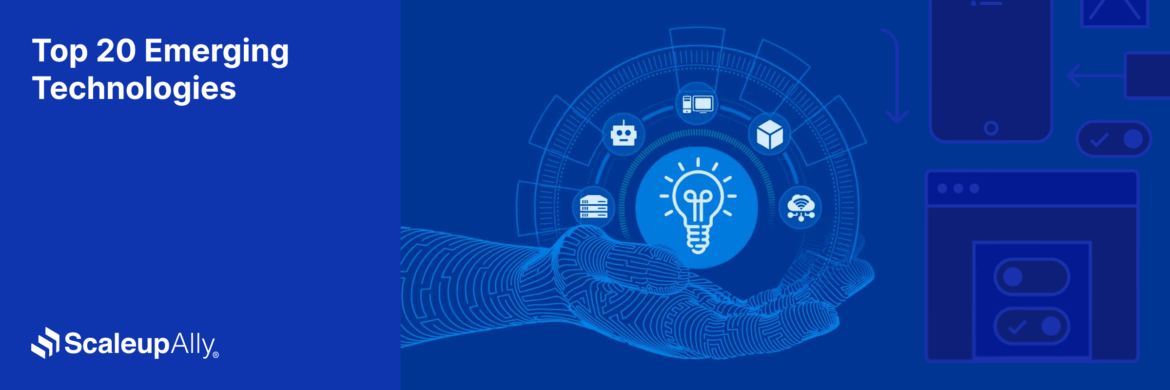
Top 20 Emerging Technologies of 2026
Discover the top 20 emerging technologies of 2026. Explore which innovations are driving change across healthcare, finance, manufacturing, and other crucial industries.
ScaleupAlly Team
Dec 16 ,
9 min read
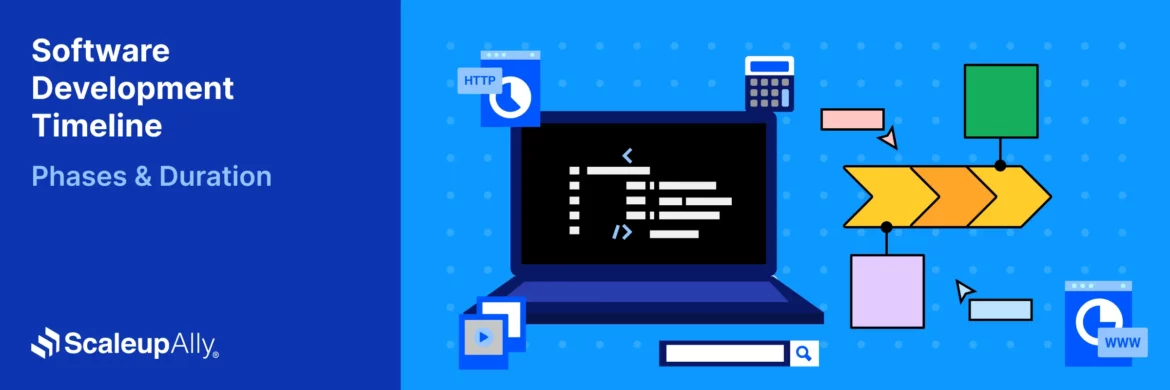
Software Development Timeline: Phases, Duration & Estimation Guide
Understand the software development timeline with phase durations, key factors, hidden delays, and practical methods to estimate project time.
Suprabhat Sen
Nov 29 ,
16 min read
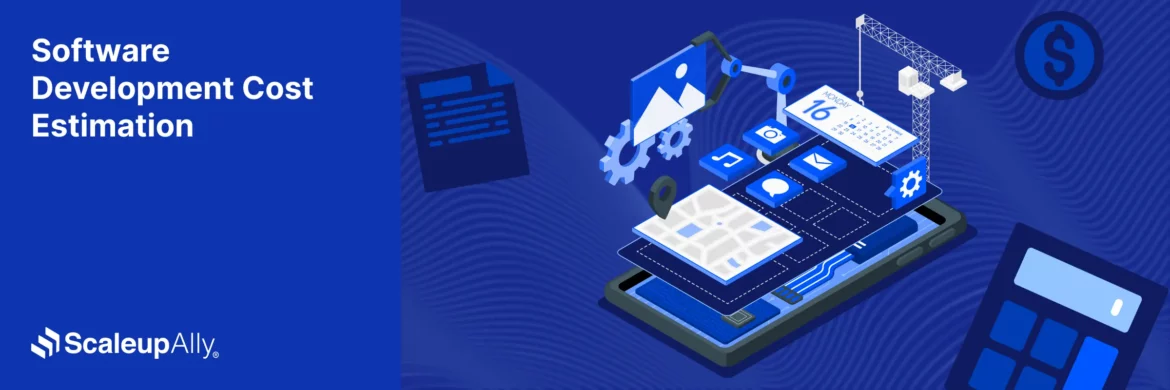
Software Development Cost Estimation Guide: What’s Included & What Affects the Price
Explore software development cost components, major pricing factors, and practical estimation methods to plan your project accurately from start to finish.
Suprabhat Sen
Nov 29 ,
14 min read


